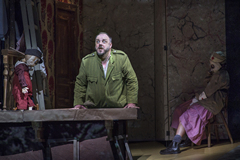| Opera Reviews | 16 April 2024 |
A compelling and highly complex productionby Moore Parker |
|
| Berg: Wozzeck Salzburg Festival 14 August 2017 |
|
|
Yet this compelling and highly complex production is innominate and timeless in its message - despite its frightful charcoal drawings in stills or in cartoon reels specifically recalling photographic quality of the early 20 century, an historic map of war-torn France, images of combat between identifiable sketched uniforms, and a threatening Zeppelin traversing the skies. Grey images of a dead forest, a deserted battlefield, a sky raining blood, young cavalry members and their horses dissected by the ravages of war - here and there interspersed with explosive flashes of coloured light! This is the backdrop to a meandering gallery, at times almost undefined in time and space, then specific - such as in an enormous cupboard which opens-up for Wozzeck’s examination with the Doctor, or through clearly-defined lighting (Urs Schönebaum) focussed on individual protagonists, or in scenes such as the party (powerful chorus work by the Konzertvereinigung Wiener Staatsopernchor) and its insanely-frenetic dance of chairs. The entire event may as much represent a reflection of Wozzeck’s ravaged mind as a narrative or prophetic warning. Robotic - almost ghoul-like, gas-masked figures hobble across the stage echoing the projected images, and connoting a chilling kinship with Wozzeck and Marie’s child - a poignantly-pathetic life-sized puppet, with gas-mask lenses for eyes - an inert individual reliant upon external impetus for life. Two Red Cross-clad puppeteers (firstly Claudia Carus, then Gregor Schulz - and then both simultaneously as the child is orphaned) perform a remarkable task in remaining discreet while drawing personality and expression from the inanimate object. Incidentally, Kentridge’s first project directing theatre was with a puppet company. The play was Büchner’s Woyzeck. Salzburg's fine cast included characterful portraits by Heinz Göhrig (Der Narr) and Mauro Peter (Andres) to compliment Jen Larsen’s sonorous and superbly deadpan Doctor, Gerhard Siegel’s choicely- typecast Hauptman, and John Daszak’s strutting and clarion Tambourmajor. Asmik Grigorian arguably created the most-rounded and touching figure of the evening, conveying with extraordinary intimacy Marie’s many facets through her artless body language and potent vocal expression - effortlessly spanning the warm maternal moments through those of regret and guilt, to searingly dramatic despair, and creating an individual about whom one cares when the tragedy is over. Matthias Goerne’s robust physique and aura imply a sense of strength - paralleling Wozzeck’s endurance in defiance of his wretched state, and particularly underscoring his capitulation when losing his only purpose in life. Goerne’s affinity with the German Lied underpins his fastidious articulation and attention to word - occasionally, however, thwarted by moments lost (aurally) due to the lack of vocal “blade” needed to penetrate through some of the richer orchestral passages. A noble reading, if not one to eclipse memories of Walter Berry. In the pit of the Haus für Mozart, Vladimir Jurowski maintained excellent balance with the stage, discreetly underscoring the demanding visual aspect of the evening with the inimitable Vienna Philharmonic Orchestra at their best. This is a co-production with the Metropolitan Opera, New York, The Canadian Opera Company and Opera Australia.
|
|
| Text ©
Moore Parker Photo © Salzburger Festspiele / Ruth Walz |

 The effect of war and squalor on the human psyche is the essence of William Kentridge’s new Wozzeck reading, with visual elements focussing upon the period of Berg’s composition of the opera and World War I - in which (as an Austro-Hungarian) Berg was forced to serve, and during which time his work on Wozzeck was interrupted. In a letter to his wife in 1918, the composer drew parallels between himself and the stage figure he was creating - “.. I have been spending these war years just as dependent on people I hate, have been in chains, sick, captive, resigned, in fact humiliated”.
The effect of war and squalor on the human psyche is the essence of William Kentridge’s new Wozzeck reading, with visual elements focussing upon the period of Berg’s composition of the opera and World War I - in which (as an Austro-Hungarian) Berg was forced to serve, and during which time his work on Wozzeck was interrupted. In a letter to his wife in 1918, the composer drew parallels between himself and the stage figure he was creating - “.. I have been spending these war years just as dependent on people I hate, have been in chains, sick, captive, resigned, in fact humiliated”.





